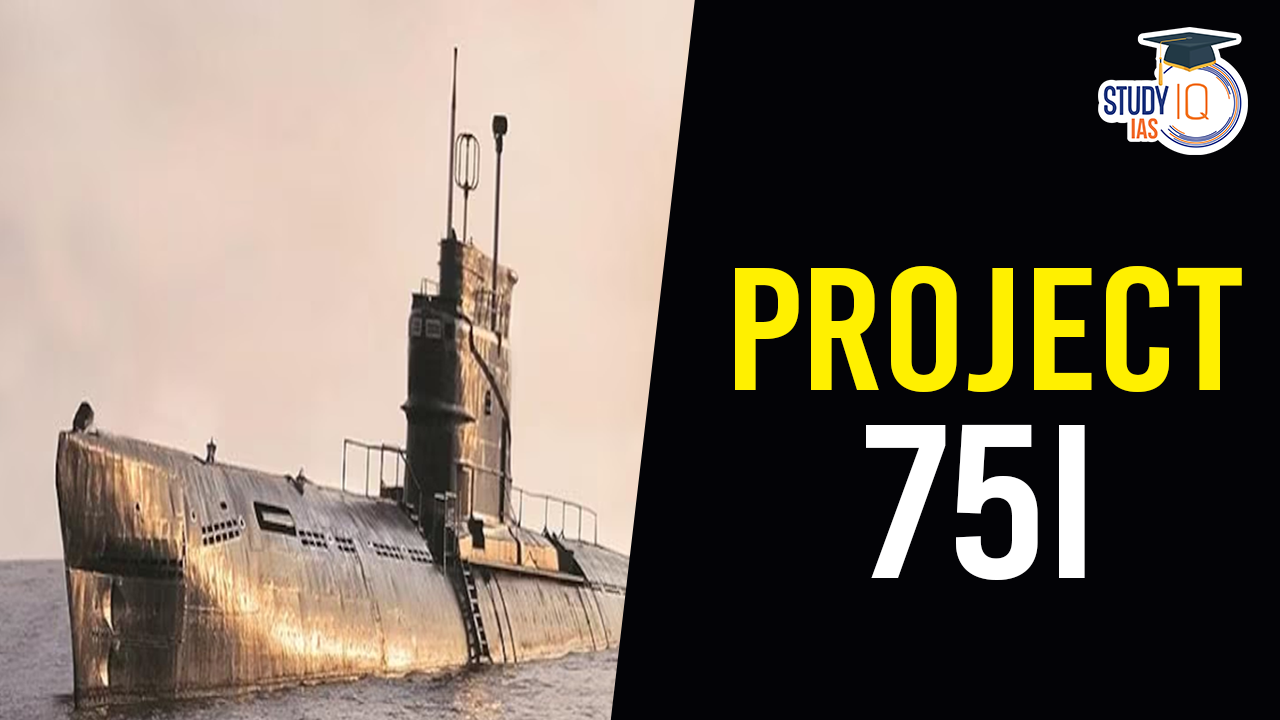Table of Contents
Context
- The German government is considering taking a stake in submarine manufacturer Thyssenkrupp Marine Systems (TKMS).
- This move aligns with TKMS’s interest in increasing shareholder confidence and potentially strengthens India’s position in the Project-75I submarine deal.
About Project-75I
Project-75I is a military acquisition program by India’s Ministry of Defence (MoD) aimed at procuring six advanced diesel-electric submarines with Air Independent Propulsion (AIP) for the Indian Navy.
Background of India’s Submarine Projects Under Project-75I
- Project 75 Initiation:
- Conceived in 1997 for the construction of two indigenous SSK submarines, Type 1500.
- Approved by the Cabinet Committee on Security (CCS) of the Ministry of Defence (MoD).
- Scorpene Submarine Adoption:
- In April 2001, collaboration with Thomson-CSF (TCSF) was discontinued when the Indian Navy chose to adopt the Scorpene design.
- Technology Transfer (TOT) was offered by French naval firm Armaris (now Naval Group).
- Implementation Phases:
- Phase I included constructing some submarines at Mazagon Dock Limited (MDL) under Project 75.
- Phase II aimed at additional submarines built later using indigenous capabilities.
- Financial and Operational Challenges:
- In 1999, the MoD approved a 30-year plan for 24 submarines.
- Financial constraints limited operational status to only six Kalvari-class submarines by the mid-2030s.
- Construction delays were caused by technology adoption challenges, industrial infrastructure issues, and procurement delays.
- Escalation of Costs: The project cost rose from Rs 12,609 crore to Rs 23,562 crore between 2002 and 2010 due to inflation and exchange rate variations.
- Exclusion of Indian Shipyards
- In 2013, the Indian Navy excluded Indian shipyards from Project 75 construction due to delays at MDL.
- MDL, Hindustan Shipyard, L&T, and Pipavav were shortlisted but faced reluctance due to delays in the Scorpene project.
- Strategic Partnership Policy
- Strategic Partnerships in the Defence Sector were finalised as a part of the Defense Procurement Policy (DPP) 2016.
- Foreign firms must now partner with Indian companies for major projects.
- The defence ministry has favoured a proposal to build four Project-75I submarines at Mazagon Dock, Mumbai (MDL), and the remaining two through the designated “strategic partner”.
Project-75I Key Features and Improvements
- Project-75 (India), also known as P-75(I), is a military acquisition initiative by the Ministry of Defence (MoD).
- The initiative aims to procure diesel-electric attack submarines with fuel cells and Air-Independent Propulsion System (AIP) for the Indian Navy to build India’s naval strength and develop indigenous submarine-building capabilities.
- Project 75I succeeded Project 75, under which six Kalvari-class diesel-electric attack submarines, modelled on the Scorpene class, were constructed.
- Six submarines in this project: INS Kalvari, INS Khanderi, INS Karanj, INS Vela, INS Vagir, and INS Vagsheer.
- AIP Technology:
- Allows submarines to stay submerged for up to two weeks without surfacing.
- This greatly enhances their operational capabilities and reduces detection risk.
- Other Features:
- Advanced stealth design, including acoustic absorption.
- Long-range guided torpedoes and anti-ship missiles.
- Sophisticated sonars and sensor suites.
- Cost: In June 2021, the defence ministry issued a tender to build six conventional submarines at about Rs 43,000 crore, making it India’s largest acquisition project.
- TKMS and Spain’s Navantia are the only two bidders in the project.
- Compliance checks and evaluations of both bids are underway, with TKMS passing its field evaluation trials (FET) in March 2024.
- Navantia’s trials are expected to conclude before June.
- TKMS Submarine Design for P-75I:
- TKMS is offering a design based on its successful Class 214 and Class 212CD submarines.
- The proposed submarine will feature an angular design to minimise radar cross-section.
- TKMS’s Indian partner, Mazagon Dock Shipbuilders Limited (MDL), has started the first phase of submarine design.
Emphasis on Indigenization and Benefits
- Gradual Increase: The Request for Proposal (RFP) specifies an initial indigenous content (IC) of 45% in the first submarine, increasing to 60% by the sixth.
- The final design is a joint effort of TKMS and MDL.
- India will own the submarine design, including rights for future integration of indigenous equipment.
- Boost for MSMEs: The project will benefit both core submarine manufacturing and smaller industries supplying parts and equipment (MSMEs).


 Utkal Divas 2025: Odisha Foundation Day ...
Utkal Divas 2025: Odisha Foundation Day ...
 NASA Parker Solar Probe Flies Closer to ...
NASA Parker Solar Probe Flies Closer to ...
 List of Military Exercises of India 2024...
List of Military Exercises of India 2024...





















